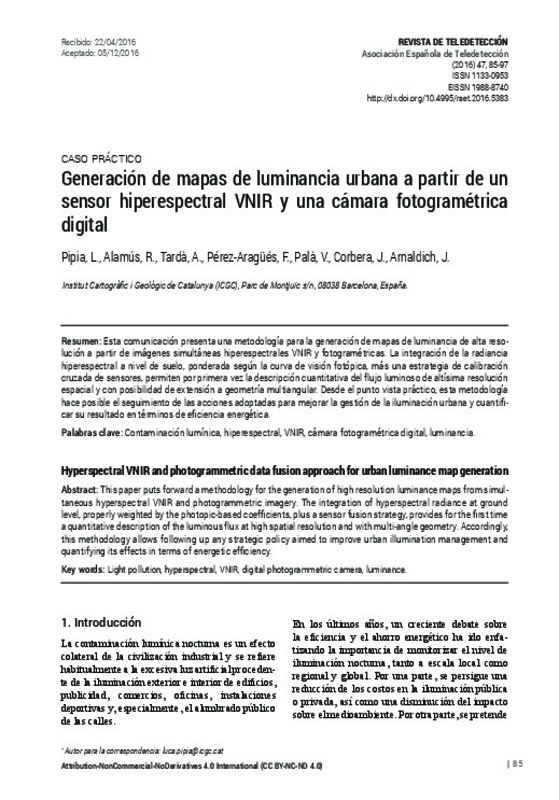JavaScript is disabled for your browser. Some features of this site may not work without it.
Buscar en RiuNet
Listar
Mi cuenta
Estadísticas
Ayuda RiuNet
Admin. UPV
Hyperspectral VNIR and photogrammetric data fusion approach for urban luminance map generation
Mostrar el registro sencillo del ítem
Ficheros en el ítem
| dc.contributor.author | Pipia, L.
|
es_ES |
| dc.contributor.author | Alamús, R.
|
es_ES |
| dc.contributor.author | Tardà, A.
|
es_ES |
| dc.contributor.author | Pérez-Aragüés, F.
|
es_ES |
| dc.contributor.author | Palà, V.
|
es_ES |
| dc.contributor.author | Corbera, J.
|
es_ES |
| dc.contributor.author | Arnaldich, J.
|
es_ES |
| dc.date.accessioned | 2017-05-02T10:24:21Z | |
| dc.date.available | 2017-05-02T10:24:21Z | |
| dc.date.issued | 2016-12-27 | |
| dc.identifier.issn | 1133-0953 | |
| dc.identifier.uri | http://hdl.handle.net/10251/80309 | |
| dc.description | Revista oficial de la Asociación Española de Teledetección | |
| dc.description.abstract | [EN] This paper puts forward a methodology for the generation of high resolution luminance maps from simultaneous hyperspectral VNIR and photogrammetric imagery. The integration of hyperspectral radiance at ground level, properly weighted by the photopic-based coefficients, plus a sensor fusion strategy, provides for the first time a quantitative description of the luminous flux at high spatial resolution and with multi-angle geometry. Accordingly, this methodology allows following up any strategic policy aimed to improve urban illumination management and quantifying its effects in terms of energetic efficiency. | es_ES |
| dc.description.abstract | [ES] Esta comunicación presenta una metodología para la generación de mapas de luminancia de alta reso-lución a partir de imágenes simultáneas hiperespectrales VNIR y fotogramétricas. La integración de la radiancia hiperespectral a nivel de suelo, ponderada según la curva de visión fotópica, más una estrategia de calibración cruzada de sensores, permiten por primera vez la descripción cuantitativa del flujo luminoso de altísima resolución espacial y con posibilidad de extensión a geometría multiangular. Desde el punto vista práctico, esta metodología hace posible el seguimiento de las acciones adoptadas para mejorar la gestión de la iluminación urbana y cuantifi-car su resultado en términos de eficiencia energética. | es_ES |
| dc.language | Español | es_ES |
| dc.publisher | Universitat Politècnica de València | |
| dc.relation.ispartof | Revista de Teledetección | |
| dc.rights | Reconocimiento - No comercial - Sin obra derivada (by-nc-nd) | es_ES |
| dc.subject | Contaminación lumínica | es_ES |
| dc.subject | Hiperespectral | es_ES |
| dc.subject | VNIR | es_ES |
| dc.subject | Cámara fotogramétrica digital | es_ES |
| dc.subject | Luminancia | es_ES |
| dc.subject | Light pollution | es_ES |
| dc.subject | Hyperespectral | es_ES |
| dc.subject | Digital photogrametric camera | es_ES |
| dc.subject | Luminance | es_ES |
| dc.title | Hyperspectral VNIR and photogrammetric data fusion approach for urban luminance map generation | es_ES |
| dc.title.alternative | Generación de mapas de luminancia urbana a partir de un sensor hiperespectral VNIR y una cámara fotogramétrica digital | es_ES |
| dc.type | Artículo | es_ES |
| dc.date.updated | 2017-05-02T07:37:55Z | |
| dc.identifier.doi | 10.4995/raet.2016.5383 | |
| dc.rights.accessRights | Abierto | es_ES |
| dc.description.bibliographicCitation | Pipia, L.; Alamús, R.; Tardà, A.; Pérez-Aragüés, F.; Palà, V.; Corbera, J.; Arnaldich, J. (2016). Hyperspectral VNIR and photogrammetric data fusion approach for urban luminance map generation. Revista de Teledetección. (47):85-97. https://doi.org/10.4995/raet.2016.5383 | es_ES |
| dc.description.accrualMethod | SWORD | es_ES |
| dc.relation.publisherversion | https://doi.org/10.4995/raet.2016.5383 | es_ES |
| dc.description.upvformatpinicio | 85 | es_ES |
| dc.description.upvformatpfin | 97 | es_ES |
| dc.type.version | info:eu-repo/semantics/publishedVersion | es_ES |
| dc.description.issue | 47 | |
| dc.identifier.eissn | 1988-8740 | |
| dc.description.references | Aubé, M. 2008. Light Pollution Modelling and Detection in a Heterogeneous Environment. Proceedings of Starlight, a Common Heritage, La Palma, Espa-a. | es_ES |
| dc.description.references | Barducci, A., Benvenuti, M., Bonora, L., Castagnoli, F., Guzzi, D., Marcoionni P., Pippi, I. 2006. Hyperspectral remote sensing for light pollution monitoring, Annals of Geophysics, 49(1), 305-310. | es_ES |
| dc.description.references | Berk, A., Anderson, G. P., Acharya, P. K., Bernstein, L. S., Muratov, L., Lee, J., … Lewis, P. E. (2005). MODTRAN 5: a reformulated atmospheric band model with auxiliary species and practical multiple scattering options: update. Algorithms and Technologies for Multispectral, Hyperspectral, and Ultraspectral Imagery XI. doi:10.1117/12.606026 | es_ES |
| dc.description.references | CIE. 1926. Commission internationale de l'Eclairage Proceedings, Cambridge: Cambridge University Press. | es_ES |
| dc.description.references | Gaston, K. J., Visser, M. E., & Hölker, F. (2015). The biological impacts of artificial light at night: the research challenge. Philosophical Transactions of the Royal Society B: Biological Sciences, 370(1667), 20140133. doi:10.1098/rstb.2014.0133 | es_ES |
| dc.description.references | Kyba, C., Garz, S., Kuechly, H., de Miguel, A., Zamorano, J., Fischer, J., & Hölker, F. (2014). High-Resolution Imagery of Earth at Night: New Sources, Opportunities and Challenges. Remote Sensing, 7(1), 1-23. doi:10.3390/rs70100001 | es_ES |
| dc.description.references | Oppenheim, A.V., Schafer, R.W. 1999. Discrete-Time Signal Processing, Second Edition, Prentice-Hall Inc. | es_ES |
| dc.description.references | Zeitler, W., Dörstel, C., Jacobsen, K. 2002. Geometric Calibration of the DMC: Method and Results, International Archives of the Photogrammetry, Remote Sensing and Spatial Information Science, 2002, 34, 324-332. | es_ES |








